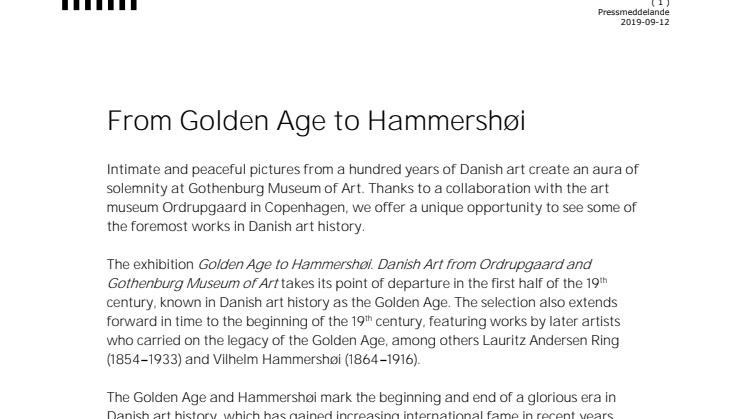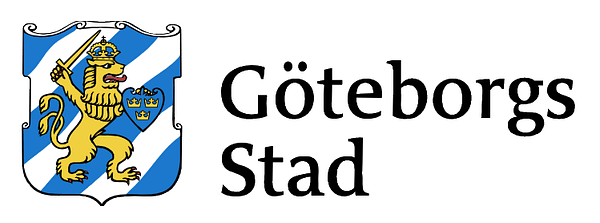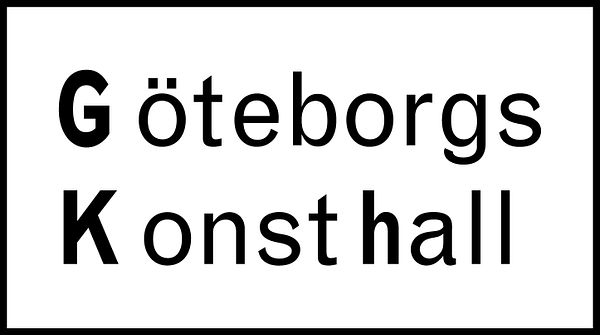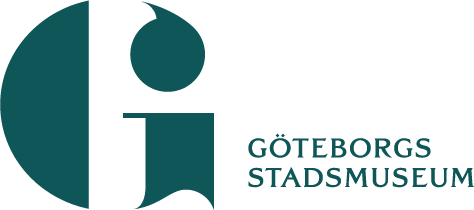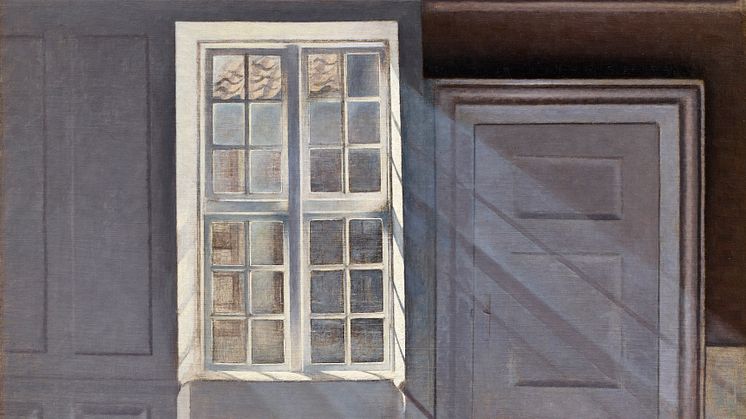
Pressmeddelande -
From Golden Age to Hammershøi
Intimate and peaceful pictures from a hundred years of Danish art create an aura of solemnity at Gothenburg Museum of Art. Thanks to a collaboration with the art museum Ordrupgaard in Copenhagen, we offer a unique opportunity to see some of the foremost works in Danish art history.
The exhibition Golden Age to Hammershøi. Danish Art from Ordrupgaard and Gothenburg Museum of Art takes its point of departure in the first half of the 19th century, known in Danish art history as the Golden Age. The selection also extends forward in time to the beginning of the 19th century, featuring works by later artists who carried on the legacy of the Golden Age, among others Lauritz Andersen Ring (1854–1933) and Vilhelm Hammershøi (1864–1916).
The Golden Age and Hammershøi mark the beginning and end of a glorious era in Danish art history, which has gained increasing international fame in recent years. The artists in the exhibition share an interest in everyday settings, undramatic landscapes and mild, moody light. With the exhibition, Gothenburg Museum of Art seeks to highlight the continuity from the first half of the 19th century until World War I.
– We are particularly pleased to be able to show Hammershøi and how his art connects back to the Danish Golden Age. Here we find something that reaches out to people today. We are bombarded with impressions, but time stands still in Hammershøi’s paintings. In his interiors, we find calm and harmony, says Per Dahlström, curator of the collection at Gothenburg Museum of Art. Furthermore, he is a painter who fascinates many contemporary artists. His paintings form a bridge between the 19th century and today.
A Golden Age for art
Despite war and economic crisis, Danish art flourished during the so-called Golden Age in the beginning of the 19th century. Characteristic of the Golden Age style is a highly detailed realism, with landscapes, cityscapes, interiors and portraits bathing in a mild light.The painters of the Golden Age created art that focussed on the intimate and everyday, rather than the grandiose or mythological. The paintings tended to be in a small format, with unassuming subject matter. Often, they were based on careful drawings, carried out in front of the motif.
– Although Golden Age paintings have an aura of calm and contemplation, there is more going on beneath the surface, says Kristoffer Arvidsson, Head of Research at Gothenburg Museum of Art. The style reflects the increasing importance of the bourgeoisie and the nascent national sentiment. People started to regard nature in a more aesthetic way than before. In this context, the landscape gained new meaning as a symbol of the nation.
Impressionism and realism
In the late 19th century, a new, dynamic period in Danish art began. This time, the inspiration came from Paris, and impressionism, which aimed to capture fleeting impressions of light and colour with lively brushstrokes. Theodor Philipsen (1840–1920) used the style to paint grazing cows in rural settings. The influence of impressionism on the Fyn painters, too, resulted in rural scenes filled with light. The group included Peter Hansen (1868–1928), Johannes Larsen (1867–1961) and Fritz Syberg (1862–1939), who depicted the fertile fields of Fyn in sun-drenched landscape paintings.
Despite the breakthrough of impressionism, the Golden Age tradition continued to exert an influence on modern painters, not least Ring and Hammershøi. Ring depicts the countryside and its invasion by modernity with psychologically charged realism, while Hammershøi renders the play of light in empty rooms. In their works, the calm has been replaced by a deceptive surface, under which we sense troubling psychological depths. These artists are both represented with around ten works.
Take time to see more
The contemplative aspect of many of the artworks is something that the museum has taken into consideration in the presentation of the exhibition. The aim is to invite the visitor to take the time to have an in-depth experience of the works. For this purpose, an audio guide provides information about where to make stops and how to see deeper layers of selected artworks. A slideshow about the exhibition also provides perspectives and additional information.
From Golden Age to Hammershøi
Danish Art from Ordrupgaard and Gothenburg Museum of Art
12 October 2019 – 22 March 2020
The etages
The exhibition, which comprises in total around seventy-five works, is produced by Gothenburg Museum of Art in collaboration with Ordrupgaard. The collection of Ordrupgaard was amassed byWilhelm (1868–1936) och Henny Hansen (1870–1951). Ordrupgaard has provided around fifty loans for the exhibition. Gothenburg Museum of Art started to systematically collect Danish Golden Age in the 1970s. Around twenty works from the collection feature in the exhibition. In addition, a few complementary works are on loan from the National Museum in Stockholm.
Press preview
Welcome to the press preview on Thursday 10 October 11.00.
Acting Museum Director Anna Hyltze welcomes everyone. Curator of the collection Per Dahlström and Head of research Kristoffer Arvidsson give a guided tour of the exhibition.
Sign up for the press preview via e-mail to eva.rosengren@kultur.goteborg.sebefore 8 October.
Contact
Eva Rosengren, Press Liaison
031-368 35 93, eva.rosengren@kultur.goteborg.se
Per Dahlström, Curator Collection
031-368 35 17, per.dahlstrom@kultur.goteborg.se
Kristoffer Arvidsson, Head of Research
031-368 35 29, kristoffer.arvidsson@kultur.goteborg.se
Anna Hyltze, Acting Museum Director
031-368 35 20, anna.hyltze@kultur.goteborg.se
Ämnen
Regioner
Göteborgs konstmuseum har en av norra Europas främsta konstsamlingar. Denna sträcker sig från 1400-talet fram till idag med betydande verk inom både nordisk och internationell konst. Förutom samlingen erbjuder museet utställningar, familjeaktiviteter, föreläsningar, workshops och visningar. Här finns restaurang samt en välsorterad museibutik. Samlingen omfattar omkring 70 000 verk och museet har ca 250 000 besökare årligen.

